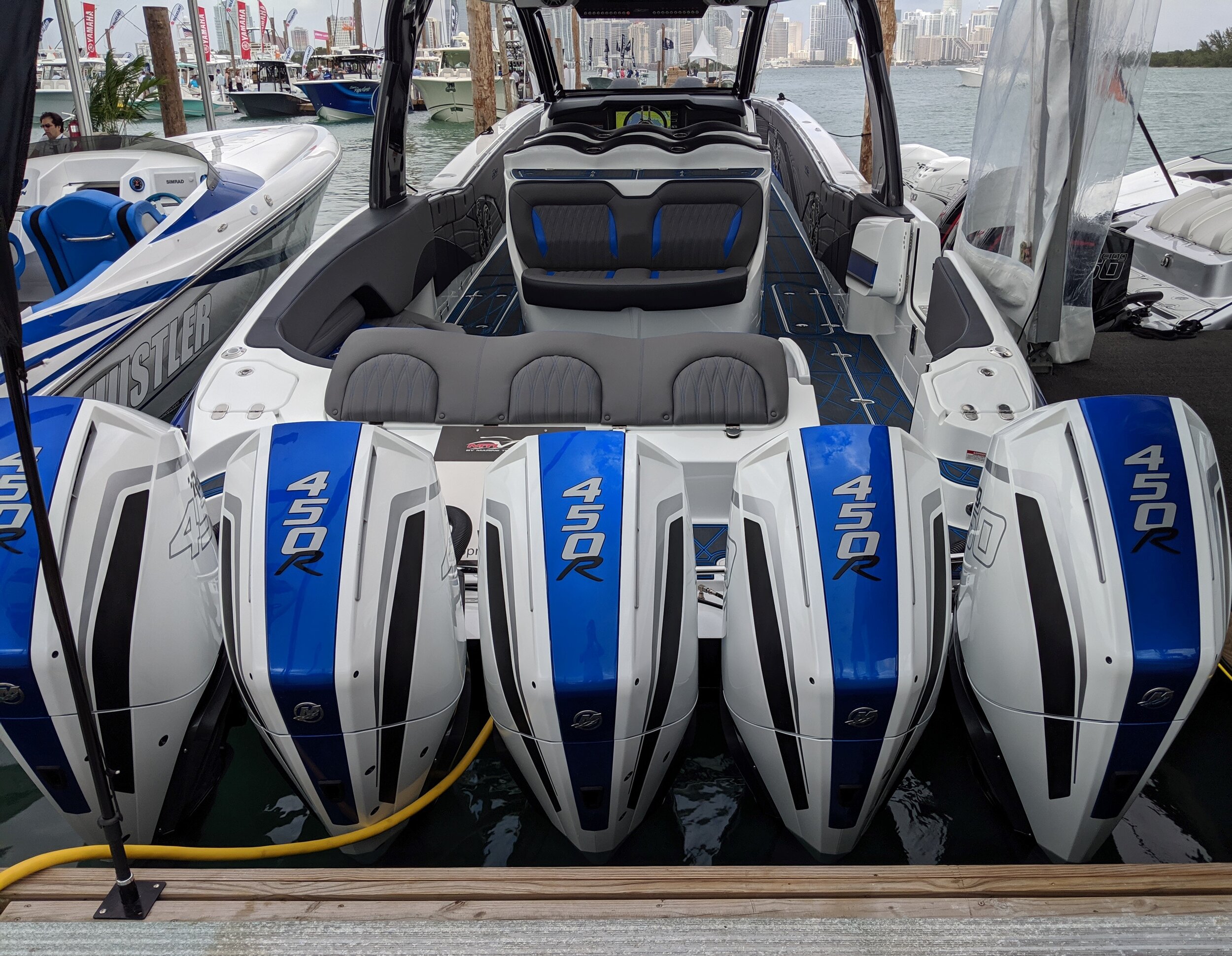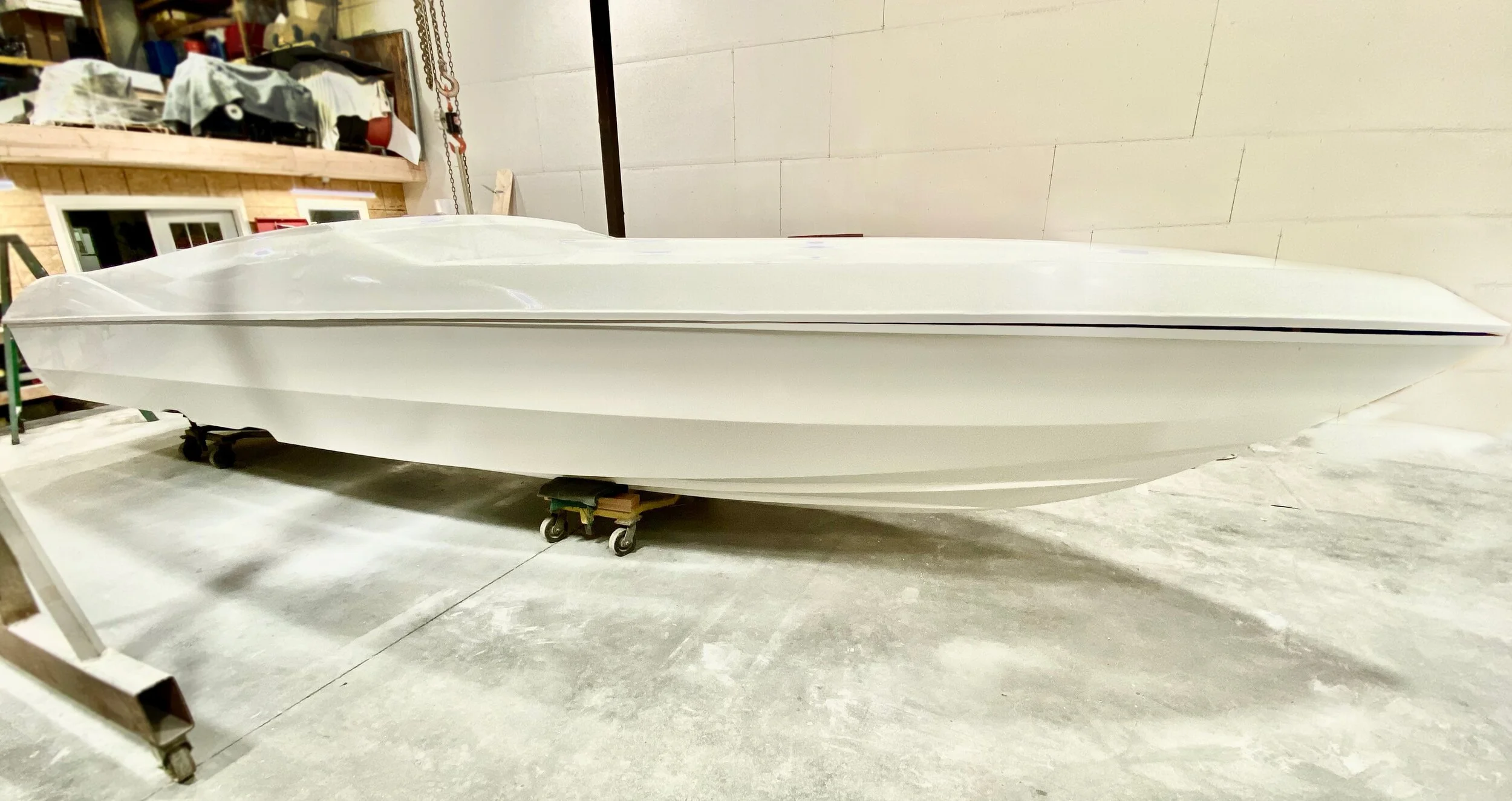Seven Marine: Innovative Outboard Startup, Market Creation and Corporate Strategy up in Smoke
I remember hearing the buzz before the 2011 Miami Boat Show about a new supercharged V8 from a new company called Seven Marine and in my recollection it sounded ridiculous. At the time, the biggest outboards were the Yamaha 350 HP V8 and the Mercury Verado 350 SCI. Boats were getting bigger and it was more common to have triples and quads on sport center consoles. Around that time, it is rumored that Eric Davis, who’s father Rick had a long influential career at Mercury Marine, hypothesized about a mega outboard producing massive power. The concept was that one mega horsepower outboard could replace two 300 or 350 HP outboards, recognizing how inefficient multi-engine setups can be. Rick was intrigued and the father son duo, both engineers, began deconstructing the idea.
If you look at the Yamaha 350 V8, it’s a massive 5.3L engine designed to push heavy boats for the long haul. Alternatively the Mercury Verado, originally a 275 HP, was pushed to 300 HP and later Mercury Racing added many upgrades and boosted the 2.6L engine to 350 HP around 2010. They were different engines, the Yamaha a big lugging 800 pound workhorse, the Verado a 650 pound high-revving tweaked engine. Eric Davis saw the limits of this power range for the niche luxury center console market and large sport fishing boats that weigh around 20,000 lbs and up.
Sophisticated design and engineering was the biggest advantage Seven Marine had. The ZF transmission allowed for the horizontal mounting of the massive GM LSA V8.
As a thesis, it makes sense; less weight and less drag is always better. Even if one mega outboard weighs 50% more and is 80% more expensive, if it replaces two outboards, one could make the case for it and that’s exactly what they did. With Eric’s brother joining the team, the Davis’ eventually created an industry changing outboard that showcased incredible engineering and prowess. Essentially, everything was outsourced, Seven Marine designed and engineered but the parts were made by other companies. This approach is smart for many reasons, especially if you don’t have a massive R&D budget out of the gate but it’s probably also one of the reasons why Seven Marine is no longer.
When Volvo Penta became the majority stakeholder in Seven Marine in 2017, everything seemed to be going well for the specialty outboard maker based in Wisconsin.
“With this acquisition, Volvo Penta is entering the outboard motor segment...Together with Seven Marine, we are on a journey to expand the scope of supply with our customers and invest in the growth of a platform to shape the future of the outboard industry.” Volvo Penta president, Björn Ingemanson.
Fast forward two and a half years and Volvo has announced they are not going to manufacture the massive V8 outboards after January 2021, even after recently updating some of the models and adding a lower horsepower model. Something changed and if you believe PR statements it is a new environmental initiative for the company, who is aiming to meet the Paris Agreement goal of being CO2 neutral by 2050.
“We want to send a clear message,” says President of Volvo Penta, Heléne Mellquist. “Volvo Penta does foresee that the outboard segment will continue to be relevant for the Marine Leisure market, but we believe that the indisputable need to drive advancements in sustainable technology must be our main focus. This is why, for the time being, the exploration of new technology together with the development of our core business, such as Volvo Penta IPS and sterndrives, will be the center of our efforts.”
If there is one takeaway, don’t ever believe company PR announcements. If Seven Marine was making money, growing market share and innovating, they would probably keep producing the outboards while evolving to meet the emission requirements they are looking to achieve along the way. Volvo Penta claims to believe in electric and hybrid technology, so it is possible Seven Marine is reincarnated when the technology allows for a low emissions 600+ HP but I wouldn’t hold your breath. Let’s think about the real reasons they announced they are ceasing production.
Seven had 3 gearcase options with multiple ratios for each one. This twin pinion high speed GT case was an option along with a standard case and later a Volvo derived contra rotating twin prop.
First, the innovation and engineering feats that the Davis’ utilized to convert a GM LSA, which is a 6.2L supercharged Aluminum V8 used in Cadillacs and Camaros, into one of the coolest looking outboards to ever grace the water is a substantial achievement. It can’t be said enough how difficult it would be to design and engineer a piece like that. The horizontal mounted engine, coupled to a special ZF transmission that transferred power with a 90 degree gearset and utilized hydraulic clutches, made for a formidable package. Originally launched as a 557 HP, the company later made models ranging from 527 HP to 627 HP. They all had custom cowls in any color you like and custom materials. They got many things right and the design was absolutely incredible. Seven Marine outboards looked sleek and stunning.
A cutaway of the 527 HP model. Every engine was bespoke in a way, custom cowl colors and materials, shaft lengths in 1 inch increments for very specific applications. The details were impressive.
Seven Marine had other features early, they used a fly by wire joystick system that could incorporate bow thrusters. And, Seven used a unique closed cooling system, where glycol coolant transfers heat to sea water in an enclosed system, to prevent corrosion and keep the big V8 cool in the marine environment. Every piece of the engine was well thought out and everything was essentially outsourced. The supply chain was slightly complicated.
The benefit of being a design firm and outsourcing is that you can put the best pieces together and avoid the extreme cost of developing each part. You take an engine from GM, transmission from ZF Group, gearcase from Selva, have adjacent parts fabricated, design custom parts like the cowling to be manufactured by a third party; this works very well for low production niche market products. But when a larger manufacturer like Volvo wants to grow and you have a very consorted supply chain, it becomes complicated. Scale is difficult, margins are tighter and Volvo needs proprietary technology. This is just one of the problems.
Volvo took a stake in Seven in 2017 but in the end they didn’t have the chops to make Seven their own and innovate further in the outboard space. Seven was an amazing design and engineering firm.
One major problem with Seven Marine was actually part of their early success. There is a marketing concept called first mover advantage. The idea is that if you can be first to market with a new or differentiating technology, you have a significant advantage. This advantage is precarious though because there are other dynamics at work. Not every fist mover wins because if an incumbent can just replicate or adapt and outspend you, then your advantage may be fleeting, however if you can match proprietary technology, sound marketing and build a loyal following, small companies can build market share with first mover advantage.
This can be complicated but consider that Seven Marine tested the market for big power luxury outboards. Seven had more features and options than anything from Yamaha and Mercury by a long shot, from multiple gear ratios, custom shaft lengths among other options. Of course, they were priced accordingly. Mercury and Yamaha were slow to respond and didn’t actually try to meet the market that Seven was in because it would be too expensive and low volume for them. But, both Mercury and Yamaha clearly saw over time that they could move upmarket, so 400+ HP outboards became viable. Seven laid out a blueprint for the market on pricing, features and power. The Yamaha 425 XTO and Mercury 400 Verado and Mercury Racing 450R are Seven Marine killers; more value for the customer, better margin for the manufacturer. Sure, they aren’t 627 HP but that’s a small market, 400 to 500 HP is much larger.
The Mercury Racing 450R is a Seven Marine killer, with it, the 400 Verado and Yamaha 425 taking away massive market share from Seven. Distribution and service are huge advantages.
In technology, there are a few different ways of looking at it but essentially it comes down to pace of technology and pace of market that have a significant impact on the longevity of first mover advantage. Technology in outboards moves very slow as does the market. Mercury and Yamaha could easily match the features of Seven Marine and come within striking distance of the benefit, which was power. Could Volvo have innovated over time and kept an advantage? Possibly. A mild hybrid 600 HP outboard with more torque, more efficiency and low emissions would be killer and probably a real first mover advantage but it’s not to be for now. Seven will cease production in January 2021.
One important note is that Former Volvo CEO Björn Ingemanson, a champion of the Seven deal was replaced in June this year by Heléne Mellquist. And Volvo Americas president Ron Huibers retired recently. This explains the strategy shift among the factors above. Eric and Brian Davis left the company shortly after as well.
The massive Yamaha 5.6L 425 XTO is packed with features and is very popular in the sport fishing market. The electric steering system really stands out.
Nothing about Volvo Penta’s inability to carry Seven Marine forward is a knock on on Eric, Rick and Brian Davis at all. The opposite actually. They did what Volvo and others couldn’t and the Seven Marine outboard was a truly remarkable product that changed the marine industry. In one way, Seven is American innovation at its finest. Three guys from Wisconsin imagined something that nobody else thought was possible, they built it and took on the world. Seven Marine outboards were works of art and took incredible imagination and capability to build. And I am so glad they did because whatever they build next will also be incredible and they inspired others to think big. They made an impact.
The biggest of them all, the 627 S. When I was a kid a 600 HP stern drive was a big deal, the idea of a turnkey warrantied 627 HP outboard would’ve seemed impossible.













